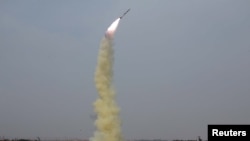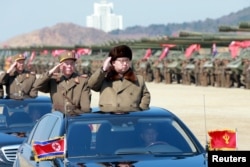South Korea said Tuesday it has concluded that North Korea is now capable of mounting a nuclear warhead on its medium-range missiles.
"We believe they have accomplished miniaturization of a nuclear warhead to mount it on a Rodong missile," a Seoul official said of Pyongyang's weapons program.
The official said Seoul has no evidence that North Korea had actually deployed such a nuclear-tipped missile, but the new assessment is the first direct acknowledgement of the North's growing nuclear prowess.
The Rodong missile can fire a 500-kilogram warhead a distance of up to 2,000 kilometers, which would put all of South Korea, most of Japan and parts of Russia and China in range.
Rodong stockpile
South Korea said it believes Pyongyang has a stockpile of 200 Rodong missiles, but may be years from being able to develop a nuclear-tipped intercontinental ballistic missile that could target the United States.
The South Korean assessment of the North's nuclear missile capability comes as a U.S. think tank, the U.S.-Korea Institute at Johns Hopkins University, said that recent satellite images of North Korea's main nuclear complex show suspicious activity that could indicate it is reprocessing plutonium for additional nuclear bombs.
The think tank's analysis focused on exhaust fumes from a steam plant used to heat a radiochemical laboratory facility at North Korea's Yongbyon complex.
North Korea has carried out four nuclear tests -- the most recent in early January -- and test-fired missiles in defiance of sanctions against such tests imposed by the United Nations Security Council.
Chief ally
China, North Korea's chief ally, stiffened its resolve Tuesday against North Korea because of the tests, banning most imports of North Korea coal and iron ore, the communist country's main exports.
In addition, Beijing's new restrictions ban most imports of North Korean gold, titanium, vanadium and rare earths, a key revenue source for the mineral-rich North.
In 2013, the U.S. Central Intelligence Agency estimated North Korea's exports at $4.4 billion, with 65 percent of that going to China.
China has balked at previous efforts demanded by the U.S. and other governments to curb trade with North Korea.












